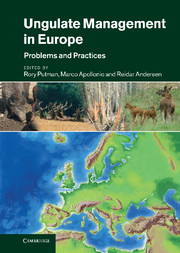Book contents
- Frontmatter
- Contents
- List of contributors
- Scientific names of species referred to in this text
- 1 Introduction
- 2 Status and distribution patterns of European ungulates: genetics, population history and conservation
- 3 A review of the various legal and administrative systems governing management of large herbivores in Europe
- 4 Hunting seasons in relation to biological breeding seasons and the implications for the control or regulation of ungulate populations
- 5 The census and management of populations of ungulates in Europe
- 6 Impacts of wild ungulates on vegetation: costs and benefits
- 7 Wild ungulate diseases and the risk for livestock and public health
- 8 Traffic collisions involving deer and other ungulates in Europe and available measures for mitigation
- 9 Large herbivores as ‘environmental engineers’
- 10 Ungulate–large carnivore relationships in Europe
- 11 The role of pathogens in the population dynamics of European ungulates
- 12 Climate change and implications for the future distribution and management of ungulates in Europe
- 13 Ungulate management in Europe: towards a sustainable future
- Index
- References
6 - Impacts of wild ungulates on vegetation: costs and benefits
Published online by Cambridge University Press: 26 April 2011
- Frontmatter
- Contents
- List of contributors
- Scientific names of species referred to in this text
- 1 Introduction
- 2 Status and distribution patterns of European ungulates: genetics, population history and conservation
- 3 A review of the various legal and administrative systems governing management of large herbivores in Europe
- 4 Hunting seasons in relation to biological breeding seasons and the implications for the control or regulation of ungulate populations
- 5 The census and management of populations of ungulates in Europe
- 6 Impacts of wild ungulates on vegetation: costs and benefits
- 7 Wild ungulate diseases and the risk for livestock and public health
- 8 Traffic collisions involving deer and other ungulates in Europe and available measures for mitigation
- 9 Large herbivores as ‘environmental engineers’
- 10 Ungulate–large carnivore relationships in Europe
- 11 The role of pathogens in the population dynamics of European ungulates
- 12 Climate change and implications for the future distribution and management of ungulates in Europe
- 13 Ungulate management in Europe: towards a sustainable future
- Index
- References
Summary
Introduction
It is recognised that wild ungulate species can have a profound effect on their environment and that this may often cause conflict with human land-use objectives (e.g. Eiberle and Nigg, 1983, 1987; Putman and Moore, 1998; Fuller and Gill, 2001; Putman, 2004). Whereas in the past much of the focus on damage by ungulates was in relation to damage to agriculture (Stahl, 1979; Gossow, 1983; Putman and Kjellander, 2002), damage to forestry through browsing and bark stripping is clearly also a major and increasing problem in many European countries (e.g. Mitchell et al., 1977; Mayer and Ott, 1991; Gill, 1992a, 1992b; Donaubauer, 1994; Kuiters et al., 1996). In agriculture impacts from wild boar especially are described once again as an ever-growing problem (e.g. Schley and Roper, 2003; Arnold, 2005; Wildauer, 2006; Wildauer and Reimoser, 2007a, 2007b; Apollonio et al., 2010a).
In some countries, there is also increasing concern being expressed about damage to conservation habitats (Reimoser, 1993, 2002; Putman and Moore, 1998; Reimoser et al., 1999; SNH/DCS, 2002; Putman, 2004; Casaer and Licoppe, 2010; van Wieren and Groot Bruinderink, 2010).
Collisions of ungulates with motor vehicles (accidents with cars, trains, etc.) are also increasing (Groot Bruinderink and Hazebroek, 1996; Putman et al., 2004; Chapter 8, this volume). Sickness transfer by wild ungulates to domestic animals and humans is a severe problem in some regions.
- Type
- Chapter
- Information
- Ungulate Management in EuropeProblems and Practices, pp. 144 - 191Publisher: Cambridge University PressPrint publication year: 2011
References
- 49
- Cited by

